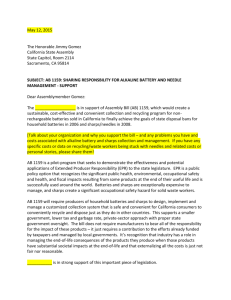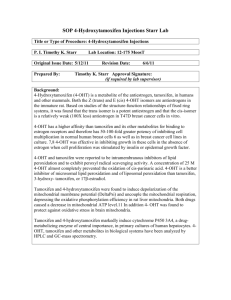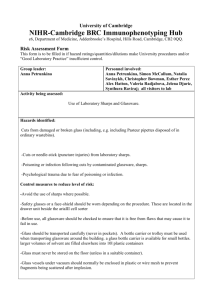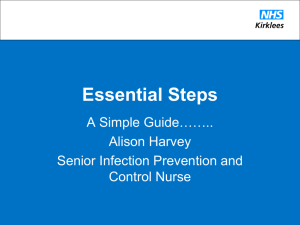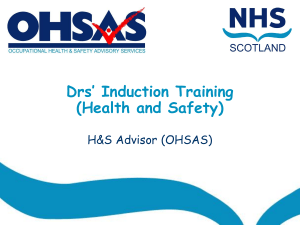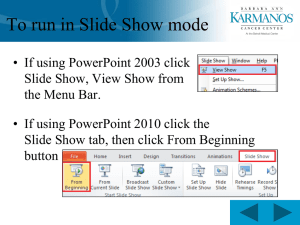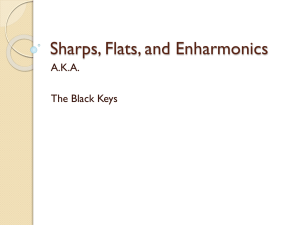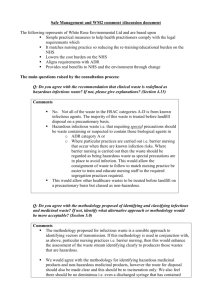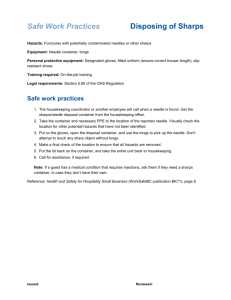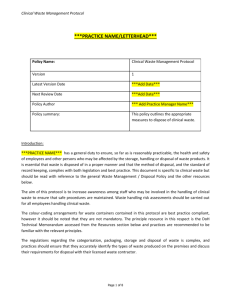Standard Operating Procedure Template
advertisement
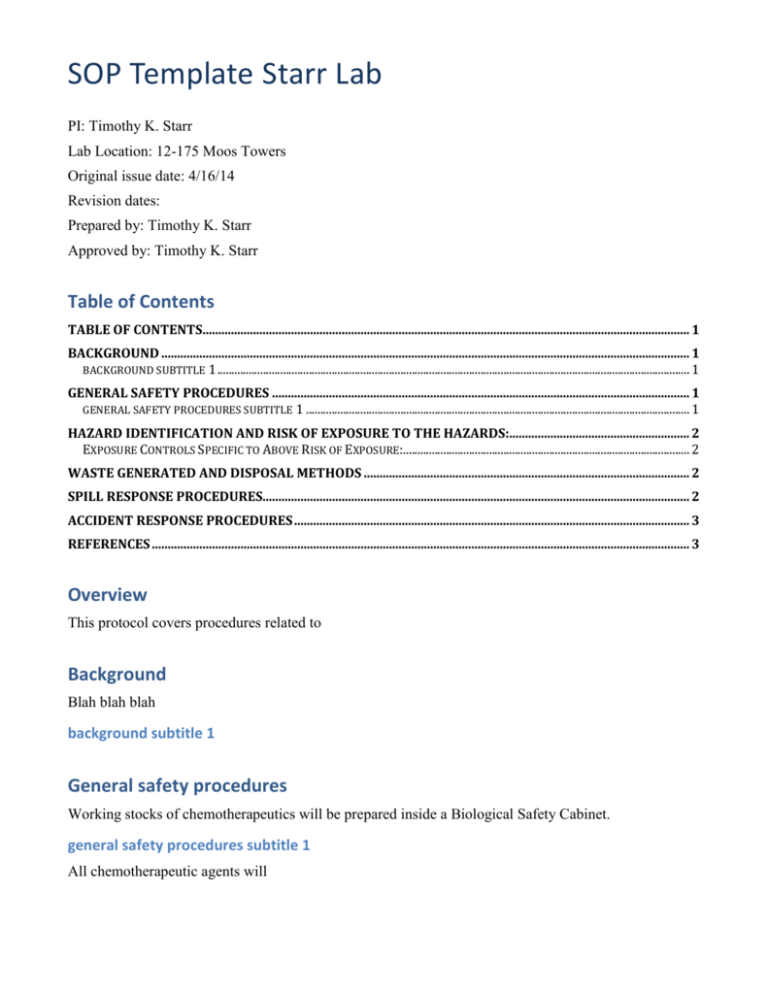
SOP Template Starr Lab PI: Timothy K. Starr Lab Location: 12-175 Moos Towers Original issue date: 4/16/14 Revision dates: Prepared by: Timothy K. Starr Approved by: Timothy K. Starr Table of Contents TABLE OF CONTENTS.......................................................................................................................................................... 1 BACKGROUND ....................................................................................................................................................................... 1 BACKGROUND SUBTITLE 1 ..................................................................................................................................................................... 1 GENERAL SAFETY PROCEDURES .................................................................................................................................... 1 GENERAL SAFETY PROCEDURES SUBTITLE 1 ...................................................................................................................................... 1 HAZARD IDENTIFICATION AND RISK OF EXPOSURE TO THE HAZARDS:......................................................... 2 EXPOSURE CONTROLS SPECIFIC TO ABOVE RISK OF EXPOSURE:.................................................................................................... 2 WASTE GENERATED AND DISPOSAL METHODS ....................................................................................................... 2 SPILL RESPONSE PROCEDURES....................................................................................................................................... 2 ACCIDENT RESPONSE PROCEDURES ............................................................................................................................. 3 REFERENCES .......................................................................................................................................................................... 3 Overview This protocol covers procedures related to Background Blah blah blah background subtitle 1 General safety procedures Working stocks of chemotherapeutics will be prepared inside a Biological Safety Cabinet. general safety procedures subtitle 1 All chemotherapeutic agents will Hazard Identification and Risk of Exposure to the Hazards: Sharps, especially needles used for injection. Never recap needles, but place directly in Sharps container. Exposure Controls Specific to Above Risk of Exposure: PPE - Lab coats, safety goggles, mask, gloves, sleeves and sharps containers. Use Biologic Safety Cabinet during preparation and handling of chemotherapeutic agents. All sharps and glass waste will be disposed of in an approved hard plastic sharps container (U Stores # CX40245, MS07407 or similar), No Cardboard sharps pouches. If exposure occurs: Consult a physician. Show the MSDS to the doctor in attendance. Move out of dangerous area. If breathed in, move person into fresh air. If not breathing, give artificial respiration. Consult a physician. In case of skin contact wash off with soap and plenty of water. Consult a physician. In case of eye contact flush eyes with water as a precaution. If swallowed never give anything by mouth to an unconscious person. Rinse mouth with water. Consult a physician. In case of accidental injection seek medical attention immediately. Waste Generated and Disposal Methods Chemotherapies are considered hazardous chemicals. Any unused chemotherapies that need to be discarded should be placed in a properly labeled hazardous waste container and disposed of by the University of Minnesota Chemical Waste Facility (part of the Division of Environmental Health & Safety). Sharps containers will be sealed when ¾ full and placed in designated waste area. In addition to unused chemical waste, the following waste disposal measures should be followed: Sharps contaminated with trace carcinogens or hazardous drugs must be disposed of in a separate sharps container that is labeled “Hazardous Sharps,” sealed, and placed in a yellow bag for incineration Residual and trace chemotherapeutic wastes, such as completely empty delivery devices, gowns, gloves, tubing, etc., should be disposed of in yellow bags for incineration. Bedding should be put in yellow bags for collection and managed as hazardous chemical waste (only while being treated with chemotherapies) Spill Response Procedures Clean up waste regularly and abnormal spills immediately. Avoid breathing dust and avoid contact with skin and eyes. Wear protective clothing, gloves, safety glasses and dust respirator. Use dry clean up procedures and avoid generating dust. Vacuum up or sweep up. NOTE: Vacuum cleaner must be fitted with an exhaust micro filter (HEPA type) (consider explosion-proof machines designed to be grounded during storage and use). Dampen with water to prevent dusting before sweeping. Place in suitable containers for disposal. If in liquid form, wipe up with paper towel. When decontaminating is finished carefully place any and all materials in appropriate biohazard bin/bag or autoclave bag. Only attempt to clean up very small powder and liquid spills (e.g., very small amounts spilled around a balance). In this situation, wear appropriate PPE as described, place wet paper towels over powder or use absorbant pads for liquid, and place all materials in leak proof container. All spill materials should be disposed of as hazardous waste through the U of M Chemical Waste Program. Larger spills should be immediately reported to DEHS for cleanup (612-626-6002). Accident Response Procedures If Incident Results in a Hazard Exposure ( i.e. face or eye splash, cut or puncture with sharps, contact with non-intact skin): Encourage needle sticks and cuts to bleed, gently wash with soap and water for 5 minutes; flush splashes to the nose, mouth, or skin with water; and flush eyes at the nearest eyewash station with clean water for 15 minutes. Call 911 or seek medical attention. o For urgent care employees may go to HealthPartners Occupational and Environmental Medicine (M/F day time or Urgent Care after hours), or UMMC-Fairview Hospital (24 hrs). You may seek medical attention at the closest available medical facility or your own healthcare provider. o Follow-up must be done by HealthPartners Occupational and Environmental Medicine. Report the incident to your supervisor as soon as possible, fill out the appropriate documentation. o Employee First Report of Injury o Supervisor Incident Investigation Report Send Incident Report Form to the IBC if exposure has occurred during work on an IBC protocol. Report all biohazard exposures to the Office of Occupational Health and Safety (612-626-5008) or uohs@umn.edu. Note: It is important to fill out all of the appropriate documents to be eligible to collect workers compensation should any complications from the hazardous exposure arise in the future. References For further information view the UMN DEHS website containing Bio Basic Fact Sheets at http://www.dehs.umn.edu/bio_basicfacts.htm. For general information on Biosafety, access the Biosafety in Microbiological and Biomedical Laboratories (BMBL) 5th Edition from the CDC at BMBL http://www.cdc.gov/biosafety/publications/bmbl5/index.htm For Material Safety Data Sheets access the Public Health agency of Canada website MSDS http://www.phac-aspc.gc.ca/lab-bio/res/psds-ftss/index-eng.php.
